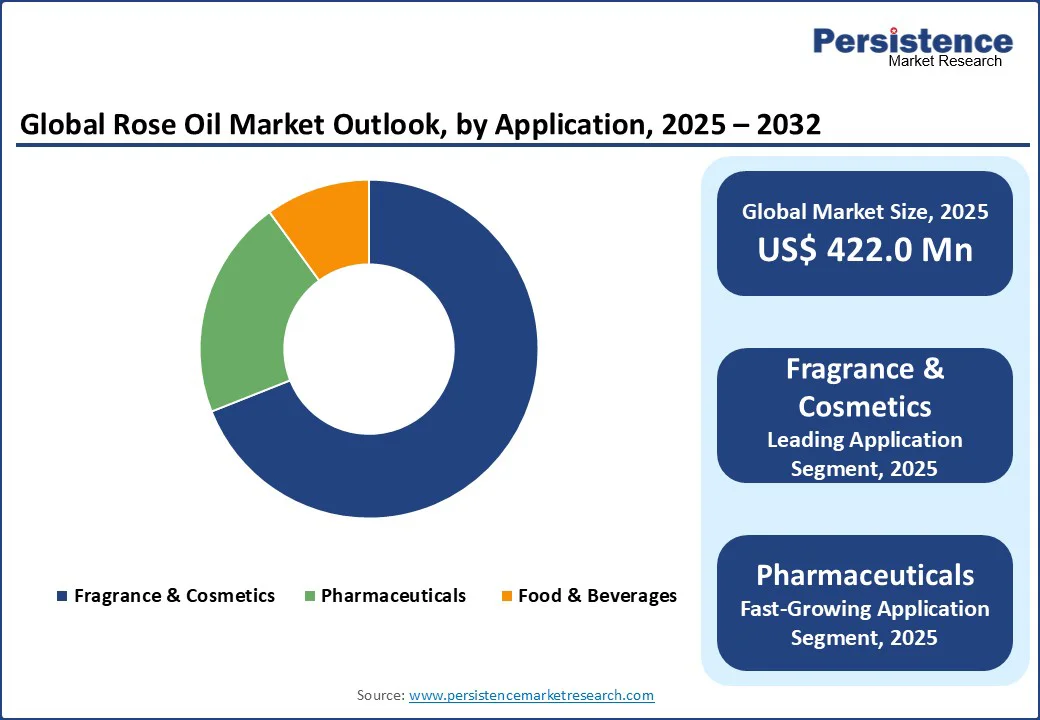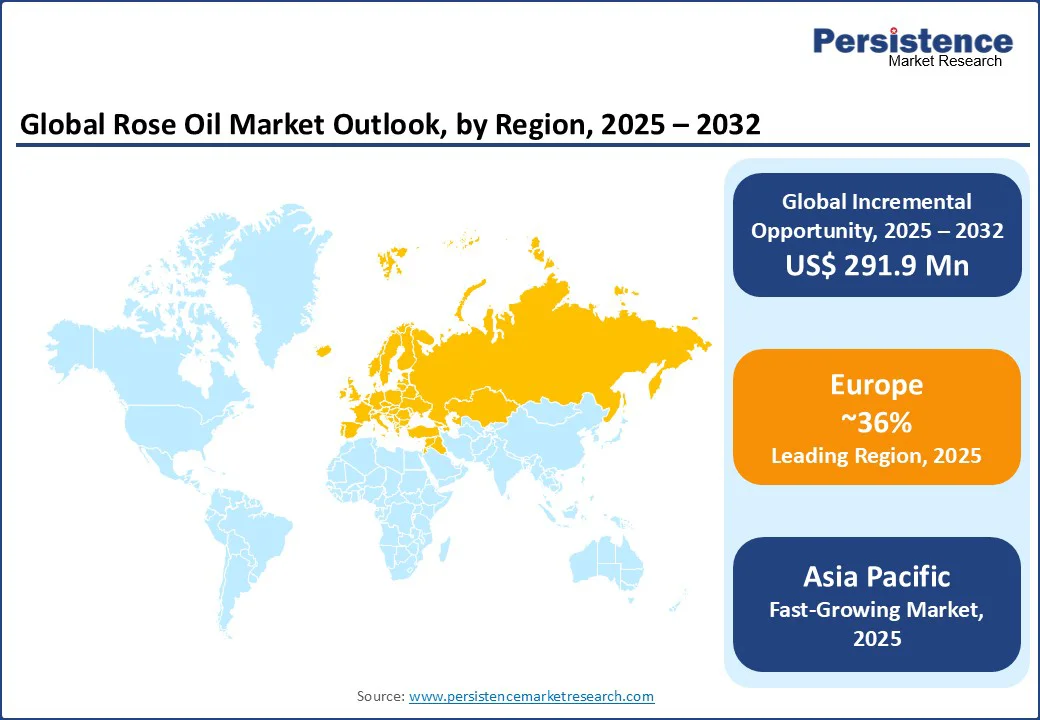ID: PMRREP21079| 180 Pages | 3 Sep 2025 | Format: PDF, Excel, PPT* | Consumer Goods

The global rose oil market size is likely to be valued at US$ 422.0 Mn in 2025 and is expected to reach US$ 713.9 Mn by 2032, registering a CAGR of 7.8% during the forecast period from 2025 to 2032.
The rose oil market has experienced steady growth, driven by increasing consumer preference for natural and organic ingredients, rising demand in the beauty and wellness sectors, and advancements in extraction technologies.
Rose oil, also known as rose otto or attar of roses, is derived from rose petals and is widely used in perfumery, skincare, and therapeutic applications due to its aromatic and medicinal properties. The growing need for premium essential oils in cosmetics and pharmaceuticals, coupled with innovations in sustainable farming and distillation methods, is fueling market expansion.
Key Industry Highlights:

|
Global Market Attribute |
Key Insights |
|
Rose Oil Market Size (2025E) |
US$ 422.0 Mn |
|
Market Value Forecast (2032F) |
US$ 713.9 Mn |
|
Projected Growth (CAGR 2025 to 2032) |
7.8% |
|
Historical Market Growth (CAGR 2019 to 2024) |
6.5% |
The rose oil market is driven by the surge in consumer demand for natural and organic ingredients across cosmetics, wellness, and personal care sectors, coupled with growing awareness of health benefits. Modern consumers are becoming increasingly conscious of the potential side effects of synthetic chemicals and are actively seeking products that are natural, safe, and environmentally sustainable. Rose oil, known for its aromatic properties, antioxidant content, and skin benefits, has emerged as a preferred ingredient in high-end perfumes, facial serums, creams, and aromatherapy products. For instance, L’Oréal’s Botanicals Fresh Care line uses rose oil as a key natural ingredient, highlighting its therapeutic and fragrance benefits.
In the cosmetics industry, manufacturers are leveraging rose oil’s natural fragrance and therapeutic benefits to develop products that appeal to health-conscious and eco-friendly consumers. Similarly, in the wellness and aromatherapy sectors, rose oil is valued for its calming, stress-relieving, and mood-enhancing properties, which align with growing trends in holistic health and self-care.
For example, Neal’s Yard Remedies incorporates rose oil in their aromatherapy blends and skincare products, promoting relaxation and skin nourishment. Regions such as Europe, North America, and Asia-Pacific are witnessing increased adoption of rose oil in premium personal care products, driven by consumer awareness and willingness to pay for organic and sustainably sourced ingredients. This trend is expected to continue boosting demand, positioning natural rose oil as a critical ingredient in the evolving beauty and wellness markets.
High production costs and supply chain vulnerabilities associated with rose oil hamper market growth. Extracting rose oil is a labor-intensive and time-consuming process, requiring large quantities of rose petals to produce a small amount of essential oil. For instance, it can take over 3,000 kilograms of rose petals to produce just one kilogram of rose oil, contributing to its premium pricing. The delicate nature of roses also demands careful cultivation, hand-picking, and specialized distillation techniques, which further increase production costs.
The rose oil supply chain is highly vulnerable to environmental and climatic factors. Adverse weather conditions, such as droughts, unseasonal rainfall, or early blooming, can drastically reduce petal yield and oil quality. Political and economic instability in major producing regions, such as Bulgaria and Turkey, can also disrupt supply, impacting global availability and pricing. These production and supply challenges make it difficult for manufacturers to maintain consistent output and meet rising demand, especially from the cosmetics, skincare, and aromatherapy sectors. As a result, high costs and supply chain vulnerabilities remain key barriers to market expansion, limiting the wider accessibility of rose oil products.
The rose oil market presents significant growth opportunities due to advancements in sustainable extraction methods and biotechnology. Traditional steam distillation and solvent extraction techniques, while effective, are often resource-intensive and costly, requiring vast quantities of rose petals. Emerging methods, such as supercritical CO? extraction and microwave-assisted extraction, offer higher efficiency, improved oil yield, and better preservation of aromatic compounds, while reducing environmental impact and water usage. For instance, the Indian company Kewalram Chanrai Group has implemented supercritical CO? extraction to produce high-purity rose oil for premium cosmetics, improving yield and sustainability.
Biotechnological advancements, including plant tissue culture and metabolic engineering, are also enabling the production of high-quality rose oil in controlled environments. For example, German biotech firm Evonik has developed cell culture-derived rose oil that maintains the fragrance and chemical composition of natural rose oil, reducing dependence on large-scale cultivation. These technologies not only enhance scalability and consistency but also appeal to environmentally conscious consumers and premium cosmetic brands. Companies adopting sustainable and biotechnological approaches can capitalize on the growing demand for organic, ethical, and high-quality rose oil, positioning themselves competitively in the expanding global market.
Conventional rose oil dominates the Rose Oil Market, expected to account for approximately 60% share in 2025. Its dominance stems from cost-effectiveness, high availability, and established supply chains, making it suitable for mass-market applications in fragrances and food flavorings. Conventional methods allow for larger-scale production, supporting demand from major industries with proven quality and consistency.
The Organic segment is the fastest-growing, driven by rising consumer preference for chemical-free products and sustainable sourcing. Organic rose oil incorporates eco-friendly farming without pesticides, appealing to health-conscious markets. The Asia Pacific region, particularly India and China, is a key contributor to this growth due to increasing investments in organic agriculture.
Fragrance & Cosmetics lead the Rose Oil Market, holding a 65% share in 2025. The essential role in creating luxurious scents and skincare benefits, including hydration and anti-aging, drives this segment’s dominance. Rose oil is integral to high-end perfumes and cosmetics, with government regulations favoring natural ingredients, further supporting growth.
The Pharmaceuticals segment is the fastest-growing, fueled by rose oil's therapeutic properties in treating anxiety, depression, and skin conditions. Increasing research on its medicinal uses, such as in aromatherapy and supplements, boosts demand. The Asia Pacific region, with traditional medicine practices in countries such as India, is a significant driver of this segment’s growth.

In North America, the rose oil market is witnessing steady growth, with the United States emerging as a key contributor. The increasing consumer preference for natural and organic products is driving demand across aromatherapy, skincare, and personal care segments. Aromatherapy applications, in particular, have seen a surge in popularity as more consumers turn to essential oils for stress relief, relaxation, and wellness benefits. Similarly, the skincare industry is incorporating rose oil into creams, serums, and other beauty products, leveraging its natural fragrance and beneficial properties for the skin.
The growth in North America is also supported by the expansion of online retail channels, making high-quality rose oil products more accessible to a wider consumer base. Increasing awareness of sustainable sourcing and ethically produced oils further enhances consumer trust and adoption. Additionally, local and international manufacturers are investing in marketing and product innovation to meet the evolving needs of health-conscious and environmentally aware consumers. While North America does not dominate global production, its market is characterized by premium product demand, strong brand presence, and high consumer purchasing power. With ongoing trends toward organic and wellness-focused products, the region is expected to maintain moderate yet consistent growth in the rose oil market over the coming years.
Europe holds a 36% share of the global rose oil market, making it the dominant region in terms of production and quality. Countries such as Bulgaria and France are the primary contributors, with Bulgaria’s Rose Valley being internationally renowned for its centuries-old tradition of rose cultivation. The region’s favorable climate, fertile soil, and expertise in traditional distillation techniques have enabled Europe to consistently produce high-quality rose oil that meets global standards for perfumery, cosmetics, and wellness applications.
Bulgaria alone continues to be a major supplier, with its rose oil prized for its rich aroma and high concentration of active compounds. France, particularly the Grasse region, also contributes significantly to the production of premium-grade rose oil used in luxury perfumes and skincare products. The sector is driven by the growing demand for natural and organic ingredients in the fragrance and cosmetic industries, coupled with rising consumer preference for high-quality, authentic rose oil. Europe’s well-established supply chains, advanced processing technologies, and long-standing expertise in rose cultivation give it a competitive advantage over other regions. With increasing global awareness about sustainable and ethical sourcing, European rose oil continues to dominate both in volume and reputation, reinforcing its position as the global leader in the domain.
The Asia-Pacific (APAC) region is emerging as the fastest-growing market for rose oil, fueled by increasing demand across countries such as India and China. The region’s growth is primarily driven by rising consumer awareness and preference for natural and organic products, especially in the cosmetics, skincare, and wellness sectors. In India, the growing middle-class population and increasing disposable incomes are accelerating the adoption of premium and natural personal care products, creating strong demand for high-quality rose oil. Similarly, in China, the expanding beauty and fragrance industry, coupled with a cultural inclination toward natural ingredients, is boosting the industry.
The rise of e-commerce platforms in the region has made premium rose oil products more accessible to consumers, further supporting market growth. Local manufacturers and startups are also investing in production and distillation technologies to meet rising demand while ensuring quality and authenticity. The APAC market benefits from the availability of raw materials and favorable agricultural conditions, enabling cost-effective production compared to other regions. With continued consumer interest in organic, sustainable, and ethically sourced products, the Asia-Pacific region is expected to maintain robust growth, offering significant opportunities for rose oil suppliers and international investors as well.

The global Rose Oil Market is characterized by intense competition, regional strengths, and a mix of established global players and innovative local manufacturers. In developed regions such as North America and Europe, major firms such as Givaudan SA, Firmenich International SA, and Symrise AG dominate through scale, advanced R&D capabilities, and strategic contracts with cosmetics giants. These companies focus on high-purity, sustainable solutions, including biotech-derived and organic oils, to differentiate themselves in fragrance and pharmaceutical applications. In the Asia Pacific, rapid wellness trends and large-scale production projects are attracting investments from international players, such as Ernesto Ventos SA, and regional manufacturers such as Alteya Organics, LLC, offering cost-effective and customized solutions. Companies are prioritizing product innovation, sustainable sourcing, and geographic expansion. Strategic partnerships, supply contracts, and eco-friendly designs, such as BERJÉ INC.’s compliance with international organic standards, are enhancing market penetration. The sector exhibits a dual structure: consolidated at the top by global leaders while remaining fragmented among regional and niche players serving application-specific and price-sensitive segments.
The global Rose Oil Market is projected to reach US$ 422.0 Mn in 2025.
Increasing demand for natural and organic ingredients in cosmetics and wellness products is our key driver.
The rose oil market is poised to witness a CAGR of 7.8% from 2025 to 2032.
Advancements in sustainable extraction and biotechnology are a key opportunity.
Sigma-Aldrich, Inc., Ernesto Ventos SA, Alteya Organics, LLC, Givaudan SA, and Firmenich International SA are key players.
|
Report Attribute |
Details |
|
Historical Data/Actuals |
2019 - 2024 |
|
Forecast Period |
2025 - 2032 |
|
Market Analysis |
Value: US$ Mn, Volume: As Applicable |
|
Geographical Coverage |
|
|
Segmental Coverage |
|
|
Competitive Analysis |
|
|
Report Highlights |
|
|
Customization and Pricing |
|
By Type
By Application
By Region
Delivery Timelines
For more information on this report and its delivery timelines please get in touch with our sales team.
About Author